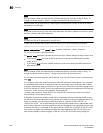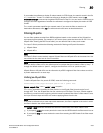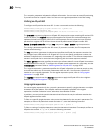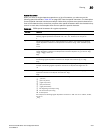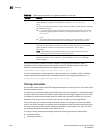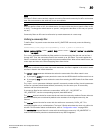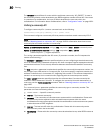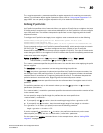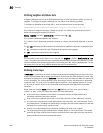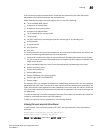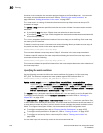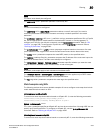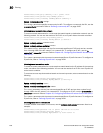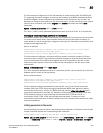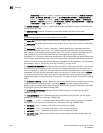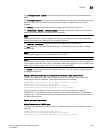
1042 PowerConnect B-Series FCX Configuration Guide
53-1002266-01
Filtering
30
Defining neighbor distribute lists
A neighbor distribute list is a list of BGP4 address filters or ACLs that filter the traffic to or from a
neighbor. To configure a neighbor distribute list, use either of the following methods.
To configure a distribute list that uses ACL 1, enter a command such as the following.
PowerConnect(config-bgp-router)#neighbor 10.10.10.1 distribute-list 1 in
This command configures the Layer 3 Switch to use ACL 1 to select the routes that the Layer 3
Switch will accept from neighbor 10.10.10.1.
Syntax: neighbor <ip-addr> distribute-list <name-or-num> in | out
The <ip-addr> parameter specifies the neighbor.
The <name-or-num> parameter specifies the name or number of a standard, extended, or named
ACL.
The in | out parameter specifies whether the distribute list applies to inbound or outbound routes:
• in – controls the routes the Layer 3 Switch will accept from the neighbor.
• out – controls the routes sent to the neighbor.
NOTE
The command syntax shown above is new. However, the neighbor <ip-addr> distribute-list in | out
<num> command (where the direction is specified before the filter number) is the same as in earlier
software releases. Use the new syntax when you are using an IP ACL with the distribute list. Use the
old syntax when you are using a BGP4 address filter with the distribute list.
Defining route maps
A route map is a named set of match conditions and parameter settings that the router can use to
modify route attributes and to control redistribution of the routes into other protocols. A route map
consists of a sequence of up to 50 instances. If you think of a route map as a table, an instance is
a row in that table. The router evaluates a route according to a route map instances in ascending
numerical order. The route is first compared against instance 1, then against instance 2, and so
on. As soon as a match is found, the router stops evaluating the route against the route map
instances.
Route maps can contain match statements and set statements. Each route map contains a
“permit” or “deny” action for routes that match the match statements:
• If the route map contains a permit action, a route that matches a match statement is
permitted; otherwise, the route is denied.
• If the route map contains a deny action, a route that matches a match statement is denied.
• If a route does not match any match statements in the route map, the route is denied. This is
the default action. To change the default action, configure the last match statement in the last
instance of the route map to “permit any any”.
• If there is no match statement, the software considers the route to be a match.
• For route maps that contain address filters, AS-path filters, or community filters, if the action
specified by a filter conflicts with the action specified by the route map, the route map action
takes precedence over the individual filter action.



